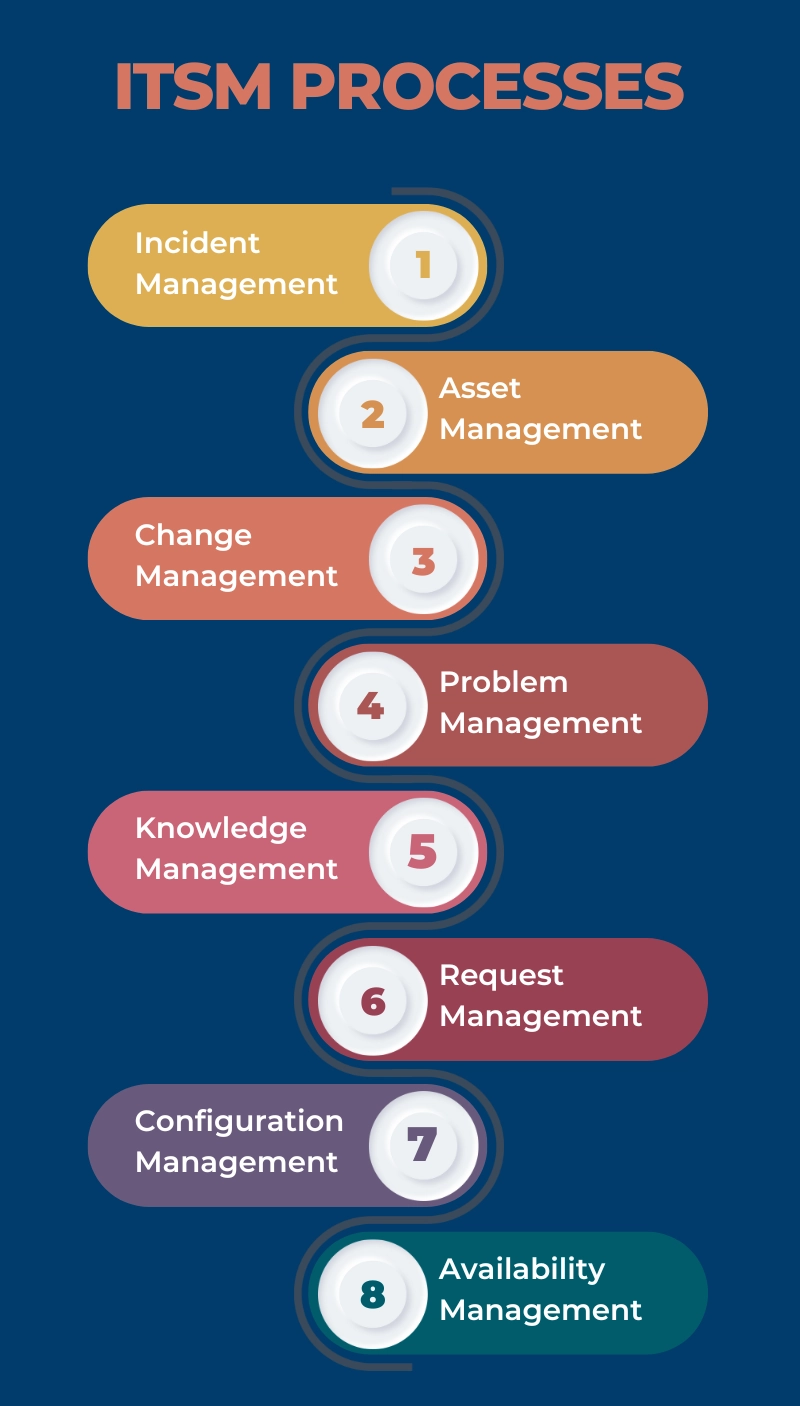As businesses continue to grow, the need for streamlining and effectively managing their IT operations becomes paramount. With teams spread all over the globe, organizations have to respond to technical challenges, track their asset locations, and respond to customer requests promptly. They must continue to drive the business forward through key IT investments — particularly when it comes to delivering IT services to their customers and employees.
This is where IT Service Management (ITSM) comes into the picture. By continuing to support your organization’s technology needs, IT service management helps you position your business better for long-term success. Implementing the right ITSM processes and tools promises many helpful outcomes including improved client and employee experience, cost optimization, integrated IT infrastructure, risk mitigation, and operational efficiencies, while also supporting capacity planning to ensure resources meet demand.
Now, let’s delve deeper to understand what ITSM is, different ITSM processes, and the benefits it brings to your organization.
What is IT Service Management?
IT service management (ITSM) refers to the processes a company uses to manage and improve the way information technology is used within its organization. The primary objective is to align the IT services with the business’s needs, ensuring that the right processes and technology are in place to help the business achieve its goals.
IT service management objectives help you ensure that every IT resource is optimally used, operated, and maintained properly for end users, irrespective of whether they are customers, employees, business partners or otherwise. These resources can span hardware, software and computing assets, ranging from individual workstations to software applications, storage solutions and virtual servers.
This standardized workflow is uniform across a range of IT tasks, including support optimization, asset management, service requests, and change management. By adopting this automated workflow, ITSM not only ensures these tasks are conducted efficiently but also maintains compliance, reduces response time, and protects sensitive data.
What are different IT Service Management processes?
There are multiple processes involved in ITSM that help companies manage their IT operations. Let’s take a look at the following key processes:

1. Incident management
Not addressing unplanned downtimes and day-to-day incidents can have severe financial consequences for your company. According to Pingdom, an average downtime in the IT industry costs about $5600 per minute, which translates to $150,000 revenue lost over an hour.
By automating incident management, ITSM swiftly addresses disruptions such as sudden server outages that might prevent your teams from accessing critical applications. A good ITSM software also helps you take a proactive approach to incident resolution so you can identify issues before they occur.
Automatic ticket creation based on predefined thresholds or anomaly detection and predictive analytics helps you foresee and mitigate these incidents.This would minimize the financial impact of disruptions and strengthen the overall resilience of your IT operations.
2. Asset management
Asset management is an important component of ITSM software that helps you manage and track the entire lifecycle of your IT assets from procurement to disposal. By streamlining inventory management, you mitigate manual data entry errors and save time. Features such as device auto-discovery, barcode scanning, lifecycle tracking and automated maintenance, and renewal alerts help you achieve these goals.
Manually conducting this entire process is quite laborious and time-intensive. This is corroborated by the fact that a staggering 80% of employees spend 30 minutes daily just to retrieve asset information manually. With a centralized database, real-time inventory data, and automated tracking, businesses can make informed decisions about allocating these resources in an efficient and cost-effective manner.
An asset management system is particularly useful in employee onboarding and offboarding. By integrating IT assets in the onboarding process, new hires promptly receive the necessary hardware and software. Conversely, during offboarding, the system ensures that all your assets are efficiently retrieved, preventing asset theft and unaccounted devices. These processes help you manage licensing standards, software compliance, and update software versions across your devices remotely.
3. Change management
As your business scales, you need to change and upgrade your IT services to adapt accordingly. This includes software updates, infrastructure modifications, and switching to a new CRM or tech stack. ITSM executes a systematic and controlled rollout to prevent potential conflicts with any existing system.
Change management is one of the most crucial elements of the ITSM framework. It involves increased collaboration among teams involved in the change process. Having alert notifications and communication channels reduces the risk of miscommunication and keeps all stakeholders well-informed. ITSM also adds real-time monitoring and reporting capabilities into change management. This allows you to assess your capabilities effectively and preempt any unforeseen issues.
4. Problem management
While incident management resolves the issue at hand, it might not address the root cause of the incident. Problem management achieves this by analyzing recurring issues and implementing robust measures to prevent these performance and delivery concerns from arising again. These issues include persistent software glitches, recurring software breaches, and frequent server downtime that impacts your business operations adversely.
ITSM would conduct an in-depth analysis of server configurations, examine your security protocols, and alert you of any vulnerabilities. This would drastically reduce the frequency of recurring incidents.
In fact, a study found that 62% of companies implementing problem management solutions experienced a significant reduction in critical disruptions over a period of 12 months. Some KPIs that will give you better insights are the number of new and closed problems, % of critical problems, and the average age of open problems.
5. Knowledge management
Knowledge Management goes beyond merely document sharing and involves creating and sharing the company’s knowledge within its teams. There are three types of ITSM knowledge:
Tacit knowledge: This knowledge stems from personal experience and insights gained through working on IT projects. For example, a seasoned IT professional in your team would know how to integrate a new CRM software based on their tacit knowledge and similar past experiences.
Explicit knowledge: This is the documented and formalized aspect of knowledge that entails FAQs, tutorials, and technical documentation. A step-by-step guide on configuring network security protocols is an example of explicit knowledge.
Implicit knowledge: Implicit knowledge is the unwritten and unspoken understanding that evolves organically in an IT environment. It is derived from the day-to-day interactions of IT teams and reflects a shared belief of best practices and common approaches. An example could be an understanding among IT teams to prioritize security patches during non-peak operational hours.
6. Request management
Request management in ITSM gives a structured approach to handling incoming requests from your employees, customers, and vendors. Through a centralized system, users can log requests and the system automatically categorizes and prioritizes them.
If a customer is unable to make a payment due to an issue with the payment gateway in your e-commerce platform, they can log a service request in your self-service portal and detail the problem. The ITSM system then swiftly identifies the relevant IT assets associated with the e-commerce platform, including payment processing modules, and transaction databases, linking them to a service ticket.
This integration not only accelerates the resolution process but also gives the customer support teams a clear view of the assets involved. This allows them to address specific issues promptly, creating a positive customer experience.
7. Configuration management
Configuration management in ITSM ensures that your hardware and software IT assets maintain a consistent and desirable state over time. This proactive approach builds consistency and compliance across your entire IT infrastructure. ITSM maintains configuration by automating tasks such as updating SSL certificates or installing a certain Windows version across all your company-wide machines.
By doing this, it reduces the risk of configuration drift, where assets deviate from their desired state over time. This automation not only stabilizes your IT services but also enhances compliance management. You can ensure that all your assets adhere to the predefined configuration standards.
8. Availability management
As a business owner, your services must be available at all times and delivered without compromising on quality. ITSM ensures that your services are meeting the expectations of end-users and customers. One of the ways it achieves this is through intelligent routing mechanisms.
IT Service Management uses advanced algorithms to optimize the flow of data and transactions so that your services remain available even during peak usage periods. It also incorporates failover and redundancy mechanisms so that in case of a system failure, the software automatically switches to backup systems. This minimizes the impact on your service availability and adds an extra layer of resilience to your IT infrastructure.
Benefits of ITSM for your business
Businesses providing ITSM services or tools help you achieve the following benefits:
Improved incident resolution
A survey by ITSM.tools showed that companies using ITSM procedures reported a 45% reduction in incident resolution time and 75% decrease in unplanned downtime. This ensures that your workforce and assets can operate at maximum productivity.
Improved customer experience
By immediately addressing any customer incidents or requests, ITSM achieves greater levels of customer satisfaction. These customers are more likely to refer your business to others.
Cost optimization
IT Service Management brings down operational costs and manual labor time by automating manual tasks and promoting self-service tools. The customer service teams don’t have to be available 24/7 to solve any service requests.
Greater data security
According to IBM’s 2023 Data Breach Report, companies are able to identify a data breach after 197 days and take another 67 days to resolve it. This huge time gap places valuable company data and confidential customer information in a vulnerable position. ITSM helps you identify and reduce potential data breaches before they escalate. This proactive approach reduces the likelihood of service disruptions and keeps your data secure.
Enhanced employee experience
By ensuring that your employees have all the right tools to get their jobs done improves productivity and employee morale. By building the right ITSM processes, you can automate recurring tasks, allocate assets quicker, and eliminate manual errors.
Scalability
As your business grows, you face the challenge of increased service requests and incorporating new technologies in your existing systems. ITSM scales your IT services through a structured approach without compromising on efficiency.
Greater return on investment
Implementing the right ITSM tool helps you get a better return on your technology investments. As you’ll be optimizing every aspect of your IT operations, it would eventually lead to optimized use of hardware devices, software applications, and peripherals. In addition, you’ll be able to increase the lifespan of your hardware assets, contributing to a greater return on investment.

Best practices to implement ITSM
1. Integrate predictive analytics:
Use machine learning algorithms to proactively identify potential issues before they disrupt your services. A predictive analytics software will anticipate trends, past incidents and historical patterns to resolve problems in a preemptive manner. This practice will lower your downtime and the costs associated with incident resolution.
2. Self- service portals:
One of the ways to magnify efficiency through ITSM is by empowering your employees and customers to help themselves. Creating self-service portals for your employees to put in requests, or to access your knowledge base for troubleshooting issues frees your IT resources to do more strategic, business-oriented tasks. In addition, your employees and customers won’t have to reach out to the concerned department for updates on their requests as all this information can be reflected in the tickets, accessible by the relevant people. Integrating your IT and business workflows like this can put employee and customer experience at the forefront of your organization.
3. Identity management integration:
One important practice businesses must implement is integrating identity management tools with ITSM software. Examples of such tools are Azure AD, Okta and OneLogin. By doing this, you’ll have more secure user access and single sign-on (SSO) functionality for your teams. This will reduce password-related vulnerabilities and prevent unwanted people from accessing your systems.
A synchronized identity management approach means that user access is immediately granted or revoked. Having this in check minimizes the risk of cyberattacks.
4. Device discovery optimization:
To optimize your ITSM approach, integrate it with device discovery and scanning solutions. These include Cisco Meraki, SCCM and Jamf Pro. By syncing the data of your Windows, Apple, or network connected-devices with your ITSM software, you’ll have increased and clear visibility into your inventory levels.
Conclusion
IT service management isn’t just about managing your routine IT tasks. It is a complete powerhouse for businesses. From managing operations to handling customer complaints, governing IT protocols, data breaches, and employee tasks, ITSM is taking the lead in allowing companies to excel in today’s competitive business landscape.
With stricter industry regulations on handling sensitive data, you need to be very particular about minimizing security breaches. When implementing ITSM, you’re not only creating a safety net, but also making a smart investment for your business’s longevity.







